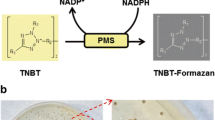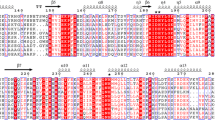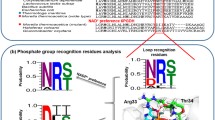Abstract
6-Phosphogluconate dehydrogenases (6PGDHs) are widely existing as reduced cofactor (NADH/NADPH) regeneration biocatalysts. Herein, a thermostable 6PGDH from Hydrogenobacter thermophilus (Ht6PGDH) was overexpressed in Escherichia coli and enzymologically characterized. Ht6PGDH exhibited exceptional stability and catalytic activity under high-temperature conditions, with an optimum temperature of 85 °C and the ability to maintain high activity for prolonged periods at 70 °C, which could be purified through a one-step heat treatment. Moreover, Ht6PGDH exhibited a preference for NAD+ with a Km value of 0.4 mM and a kcat value of 28.6 s⁻1, demonstrating a significant preference over NADP+. These properties render Ht6PGDH a potentially valuable enzyme for high-temperature bioconversion and in vitro synthetic biosystems. Additional research showed that Ht6PGDH excelled in the regeneration of NADH, achieving efficient lactate production when integrated into an in vitro synthetic biosystem containing lactate dehydrogenase (LDH). Furthermore, the cascade reaction of Ht6PGDH with glucose-6-phosphate dehydrogenase (G6PDH) was explored for NADH regeneration using starch as the substrate, further validating its potential application in complex biosynthetic systems.





Similar content being viewed by others
Data availability
The datasets generated during and/or analyzed during the current study are available from the corresponding author on reasonable request.
References
Chen H, Zhu Z, Huang R, Zhang Y-HP (2016) Coenzyme engineering of a hyperthermophilic 6-phosphogluconate dehydrogenase from NADP+ to NAD+ with its application to biobatteries. Sci Rep 6(1):36311. https://doi.org/10.1038/srep36311
Hanau S, Helliwell JR (2022) 6-Phosphogluconate dehydrogenase and its crystal structures. Acta Crystallogr Sect F 78(3):96–112. https://doi.org/10.1107/S2053230X22001091
Huang R, Chen H, Zhong C, Kim JE, Zhang Y-HP (2016) High-throughput screening of coenzyme preference change of thermophilic 6-phosphogluconate dehydrogenase from NADP+ to NAD+. Sci Rep 6(1):32644. https://doi.org/10.1038/srep32644
Huang R, Chen H, Zhou W, Ma C, Zhang YHP (2018) Engineering a thermostable highly active glucose 6-phosphate dehydrogenase and its application to hydrogen production in vitro. Appl Microbiol Biotechnol 102(7):3203–3215. https://doi.org/10.1007/s00253-018-8798-7
Ito S, Osanai T (2018) Single amino acid change in 6-phosphogluconate dehydrogenase from synechocystis conveys higher affinity for NADP+ and altered mode of inhibition by NADPH. Plant Cell Physiol 59(12):2452–2461. https://doi.org/10.1093/pcp/pcy165
Jakkula P, Narsimulu B, Qureshi IA (2021) Biochemical and structural insights into 6-phosphogluconate dehydrogenase from Leishmania donovani. Appl Microbiol Biotechnol 105(13):5471–5489. https://doi.org/10.1007/s00253-021-11434-4
Kay JE, Jewett MC (2020) A cell-free system for production of 2,3-butanediol is robust to growth-toxic compounds. Metab Eng 10:e00114. https://doi.org/10.1016/j.mec.2019.e00114
Liu J, Kang R, Yang X, Xie H, Cui X, Ren M, Feng X, Meng D (2024) Sustainable cellobionic acid biosynthesis from starch via artificial in vitro synthetic enzymatic biosystem. Int J Biol Macromol 260:129641. https://doi.org/10.1016/j.ijbiomac.2024.129641
Liu Z, Gonzalez JS, Wang H, Gunasekaran S, Runge T (2015) Dairy manure protein analysis using UV-vis based on the Bradford method. Anal Methods 7(6):2645–2652. https://doi.org/10.1039/C4AY03006K
Liyang Y, Qiang G, Jifang L, Bangyuan Z, Guilan L, JianQuan G (2022) Opportunities and challenges of in vitro synthetic biosystem for terpenoids production. Biotechnol Bioproc Eng 27(5):697–705. https://doi.org/10.1007/s12257-022-0100-2
Martins M, dos Santos AM, da Costa CHS, Canner SW, Chungyoun M, Gray JJ, Skaf MS, Ostermeier M, Goldbeck R (2024) Thermostability enhancement of GH 62 α-l-arabinofuranosidase by directed evolution and rational design. J Agr Food Chem 72(8):4225–4236. https://doi.org/10.1021/acs.jafc.3c08019
Maturana P, Tobar-Calfucoy E, Fuentealba M, Roversi P, Garratt R, Cabrera R (2021) Crystal structure of the 6-phosphogluconate dehydrogenase from Gluconobacter oxydans reveals tetrameric 6PGDHs as the crucial intermediate in the evolution of structure and cofactor preference in the 6PGDH family. Wellcome Open Res. https://doi.org/10.12688/wellcomeopenres.16572.1
Pickl A, Schönheit P (2015) The oxidative pentose phosphate pathway in the haloarchaeon Haloferax volcanii involves a novel type of glucose-6-phosphate dehydrogenase—the archaeal Zwischenferment. FEBS Lett 589(10):1105–1111. https://doi.org/10.1016/j.febslet.2015.03.026
Ribeiro C, Hennen-Bierwagen TA, Myers AM, Cline K, Settles AM (2020) Engineering 6-phosphogluconate dehydrogenase improves grain yield in heat-stressed maize. Proc Natl Acad Sci USA 117(52):33177–33185. https://doi.org/10.1073/pnas.2010179117
Scopes RK (1997) Allosteric control of Zymomonas mobilis glucose-6-phosphate dehydrogenase by phosphoenolpyruvate. Biochem J 326(3):731–735. https://doi.org/10.1042/bj3260731
Siedentop R, Claassen C, Rother D, Luetz S, Rosenthal K (2021) Getting the most out of enzyme cascades: strategies to optimize in vitro multi-enzymatic reactions. Catalysts. https://doi.org/10.3390/catal11101183
Sun Y, Zhang T, Lu B, Li X, Jiang L (2023) Application of cofactors in the regulation of microbial metabolism: a state of the art review. Front Microbiol. https://doi.org/10.3389/fmicb.2023.1145784
Wang Y, Zhang YHP (2009) Overexpression and simple purification of the Thermotoga maritima 6-phosphogluconate dehydrogenase in Escherichia coli and its application for NADPH regeneration. Microb Cell Fact 8(1):30. https://doi.org/10.1186/1475-2859-8-30
Wilding KM, Schinn S-M, Long EA, Bundy BC (2018) The emerging impact of cell-free chemical biosynthesis. Curr Opin Biotech 53:115–121. https://doi.org/10.1016/j.copbio.2017.12.019
Zhang Q, Pan B, Yang P, Tian J, Zhou S, Xu X, Dai Y, Cheng X, Chen Y, Yang J (2024) Engineering of methionine sulfoxide reductase A with simultaneously improved stability and activity for kinetic resolution of chiral sulfoxides. Int J Biol Macromol 260:129540. https://doi.org/10.1016/j.ijbiomac.2024.129540
Zhang Z, Cai D, Shao C, Chen C, Chen B (2022) Purification of high-temperature resistant polyethylene terephthalate (PET) hydrolase by simple heating protocol. Process Biochem 114:42–51. https://doi.org/10.1016/j.procbio.2022.01.011
Zhu Z, Zhang YHP (2017) In vitro metabolic engineering of bioelectricity generation by the complete oxidation of glucose. Metab Eng 39:110–116. https://doi.org/10.1016/j.ymben.2016.11.002
Acknowledgements
This work was supported by the Shandong Provincial Natural Science Foundation (ZR2023QC272).
Funding
This study was funded by Natural Science Foundation of Shandong Province, ZR2023QC272, Xinming Feng.
Author information
Authors and Affiliations
Corresponding author
Ethics declarations
Conflict of interest
All authors declare that they have no conflict of interest.
Supplementary Information
Below is the link to the electronic supplementary material.
Rights and permissions
Springer Nature or its licensor (e.g. a society or other partner) holds exclusive rights to this article under a publishing agreement with the author(s) or other rightsholder(s); author self-archiving of the accepted manuscript version of this article is solely governed by the terms of such publishing agreement and applicable law.
About this article
Cite this article
Feng, X., Cui, X., Wang, K. et al. Enzymatic characterization of a thermostable 6-phosphogluconate dehydrogenase from Hydrogenobacter thermophilus and its application for NADH regeneration. 3 Biotech 15, 3 (2025). https://doi.org/10.1007/s13205-024-04165-6
Received:
Accepted:
Published:
DOI: https://doi.org/10.1007/s13205-024-04165-6




